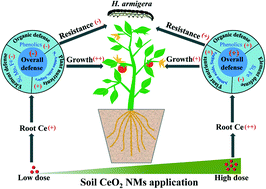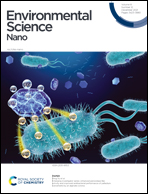Dose-dependent effects of CeO2 nanomaterials on tomato plant chemistry and insect herbivore resistance†
Abstract
The use of engineered nanomaterials (NMs) for agricultural applications is becoming increasingly interesting because NMs have been shown to promote crop yield, and also to some extent, protection against insect pests. However, we still lack evidence of the commonalties of such effects across different NMs and biological systems. For instance, although it has been shown that CeO2 NMs can promote yield in some crops, we still lack evidence for the cascading effects of Ce accumulation, via the roots, on plant physiology and plant–herbivore interaction. To address this gap, we studied the effect of soil-applied different concentrations of CeO2 NMs (0, 10, 50 and 100 mg kg−1) on tomato growth traits, changes in tomato leaf chemistry, and ultimately, on tomato plant resistance against the highly polyphagous Helicoverpa armigera caterpillars. The results showed that there was a strong dose-dependence for CeO2 NM addition to plant growth. Particularly, 50 mg kg−1 CeO2 NM addition showed the highest effect on plant growth in the presence of herbivore, via increasing shoot biomass by 38.2% as compared to the control. Such an effect aboveground correlated well with the observed positive dose-dependent effect of CeO2 on different root functional traits that facilitate nutrient acquisition. Moreover, 10 and 50 mg kg−1 CeO2 NM addition stimulated H. armigera caterpillar growth by 27.3% and 77.7%, respectively, while 100 mg kg−1 inhibited caterpillar growth by 11%. Finally, we observed that particularly 100 mg kg−1 CeO2 NMs significantly decreased leaf Si and Fe, but significantly increased plant nutrients (amino acids, soluble sugars) and chemical defense-related compounds (phenolics and flavonoids). Taken together, this study indicates that CeO2 NMs could increase plant growth and defensive chemistry, and in turn also affect resistance against pests in a dose-dependent manner. Therefore, establishing a sound application dosage is essential for promoting the environmentally-friendly application of NMs for simultaneously boosting crop yield and pest control in agricultural fields.



 Please wait while we load your content...
Please wait while we load your content...